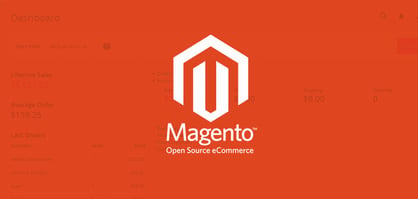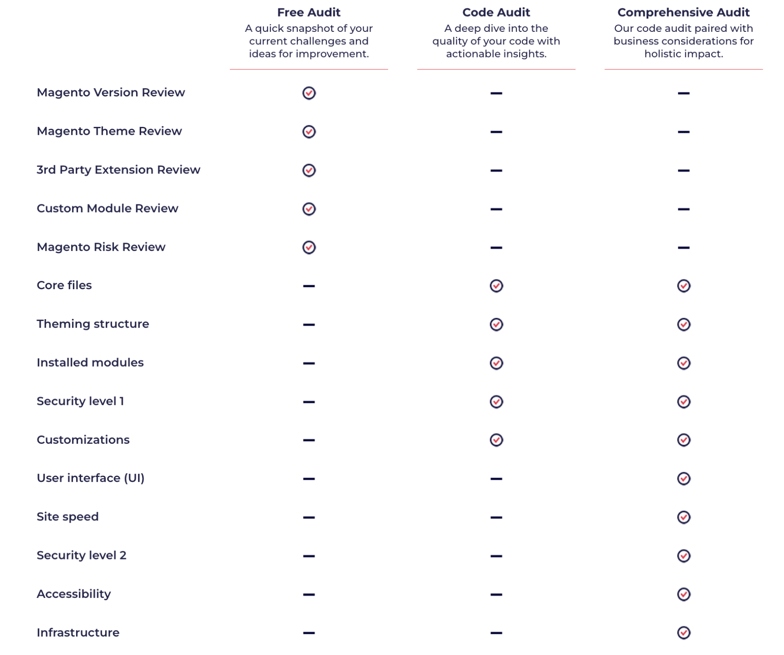Adobe Commerce vs. Magento Open Source: What’s the Difference?
Learn the differences between Magento Open Source and Adobe Commerce to help you decide what solution is best for your eCommerce business.
14 min read
 Tim Bucciarelli
:
January 5, 2023
Tim Bucciarelli
:
January 5, 2023
.png)
For many eCommerce businesses, the choice between BigCommerce and Magento looms large. Both popular platforms offer distinct advantages, catering to varying business sizes, goals, and strategies. Whether you're a burgeoning startup or an established enterprise, the decision between BigCommerce and Magento hinges on understanding their features, capabilities, and alignment with your unique needs.
In this blog, we'll explore the BigCommerce vs. Magento question, examining the nuances of each platform to provide you with the insights needed to make an informed choice.
When deciding between BigCommerce and Magento as your eCommerce platform, you need to think about a few factors that are important to your business that will lead you to success. Let's take a look at a handful of factors that we think are important for eCommerce businesses of all shapes and sizes to think about.
BigCommerce is well-suited to a broad range of businesses, including both small- to mid-sized businesses and enterprise businesses. BigCommerce fits best for those companies with relatively simple design, integration, and order processing needs. Magento, on the other hand, can accommodate greater customization of design, integration, and company-specific functional needs. Magento is typically the go-to choice for mid to large-sized businesses that need an entirely unique website with custom features.
When it comes to assessing future needs, ask yourself the following questions: How do you expect your business to evolve in the next five years? Do you anticipate needing the greater flexibility of Magento to build out new integrations and customizations or is the SaaS-based BigCommerce platform sufficient for your anticipated needs? The answers to these inquiries will help guide you.
Once you’ve defined your existing and future eCommerce needs, you may still have questions. Another way of thinking about BigCommerce and Magento is considering them as a "rent vs. buy" scenario.
With the SaaS platform BigCommerce, you are a subscriber to their services. You are able to change basic aspects of your site like colors, fonts, buttons, and page layouts, and make minor customizations with the help of a developer, but you are limited to what BigCommerce offers (the property owner). At the same time, BigCommerce takes care of maintenance and security patches for you.
With Magento, you own it, and you can build it out any way you wish. It is fully customizable, from design to functionality and integrations. But you’re also responsible for developing and maintaining the site.
It is worth noting that Magento is actually available in two different platforms:

BigCommerce is, to put it simply, a more “basic” solution when compared to Magento. Although it still requires a developer who’s experienced with BigCommerce to make the most of the platform, teams can build out their sites with everything BigCommerce has to offer. Website projects don’t take as much time, and teams can achieve their desired end product more quickly.
Overall, BigCommerce has a straightforward and intuitive interface that makes management and upkeep painless for eCommerce beginners. The platform provides:
Many smaller-sized companies find that BigCommerce meets their needs, especially if they do not have a complicated or large product catalog.
One of BigCommerce’s primary benefits is its intuitive and user-friendly interface. Most users can set up their online store by themselves if they take the time to become familiar with the platform and don’t need to delve into customizing BigCommerce features. With a range of preset templates, you can create a simple, professional-looking eCommerce store within a few weeks (even faster if you have a developer).
It also comes with an abundance of built-in features, including:
Then, maintenance is minimal after you’re up and running — BigCommerce automatically implements security patches and updates.
BigCommerce partners with 65 payment providers, allowing you to easily connect with more than 100 countries and support over 250 local payment methods. The platform also offers integrations with well-known digital and mobile wallets, including Apple Pay, PayPal, Amazon Pay, and Venmo. Setting up these payment options with BigCommerce is straightforward — connect the desired gateway and enter your login credentials.
You can also link BigCommerce with sales channels like Amazon, eBay, and Google Shopping. It integrates with a variety of software solutions, including:
These integrations allow you to easily manage orders, track inventory, and analyze data from multiple channels in a single location.
While BigCommerce offers pre-designed templates to build out website pages, the options are limited, and your store may end up looking like other stores in your niche. If you want your website to have a more unique look or different functionalities, you may need to hire a developer to make these changes.
Additional functionalities can be added to your BigCommerce site through apps. (But take note: These apps typically charge a monthly fee, which can become costly when you add multiple extensions to your site.)
However, even skilled developers are limited by what can be done within the confines of BigCommerce's existing free themes, paid themes, and extensions. If you require a high level of customization or specific features that BigCommerce doesn’t offer, it may be worth considering alternative platforms that offer more flexibility, like Magento.
BigCommerce pricing is organized by monthly plans, but each one has its own set of restrictions and limitations.
One benefit of working with BigCommerce is that you can easily upgrade from one plan to another. As your business grows, you can upgrade to the next plan and take advantage of the additional functionality.
For businesses considering the Enterprise plan, it is important to understand that the subscription fee is based on the number of transactions you process online in a given year. If you expect substantial growth in your business, it will be worth doing the math to see what your subscription fee increases might be over the course of a five-year period.
In some cases, these fees can add up quickly and Magento Open Source or even Adobe Commerce might offer a greater long-term return on your investment.
Because of the different subscription levels, small businesses with limited budgets can build a highly functional eCommerce site using BigCommerce. Mid-sized businesses with limited custom needs can choose the Pro plan and could upgrade to Enterprise if their sales volume grows. Even larger businesses can build highly performative websites with limited maintenance requirements on the Enterprise plan.
As mentioned at the start of this article, it is essential to understand your current and future needs and make sure the limits of the BigCommerce platform do not become limits to your business later on down the line. Regardless of the BigCommerce subscription you choose, many businesses can quickly launch a basic store on their own with no prior coding knowledge and without the help of a development team. The platform’s range of built-in features, including support for multiple payment methods, inventory management, and shipping options, help businesses manage their online sales with ease.
In some cases, BigCommerce store owners will still benefit from hiring a development team to work on custom designs, app installs, or limited opportunities for custom functionality. Similar to Magento and Adobe Commerce, these developer costs should be considered as part of your total cost of ownership calculations.
eCommerce sites with substantial customization needs or large annual transaction volumes will likely find Magento more beneficial and cost-effective over the long term.

When people refer to “Magento,” they’re talking about one of the two products Adobe offers: Magento Open Source or Adobe Commerce (formerly Magento Commerce).
Magento Open Source is the “freemium” version of Adobe Commerce. It’s an open-source, self-hosted eCommerce platform that has robust eCommerce features and provides a lot of flexibility to customize your site. It is suitable for businesses that have technical expertise (or are willing to hire a development agency), as it does require substantial development work to get it up and running efficiently.
Some of Magento Open Source’s features include:
While Magento Open Source is free to install, businesses using the platform must find a hosting provider and pay for customizations or additional development services. The cost of these services varies depending on the specific needs of the business. Here are estimates for some of these additional costs:
The other option is Adobe Commerce, a paid solution that includes all the features of Magento Open Source, as well as the latest functional advancements released by Adobe including features such as:
Adobe Commerce does not offer pricing information on its site, so if you’re interested in the platform, you have to contact their team to discuss your requirements and receive a custom quote. Then, you should also consider the extra costs to maintain your Adobe Commerce Store, like the cost of hiring a developer to build out and optimize your site.
Adobe’s hosted version of Adobe Commerce is called Adobe Commerce Cloud. This platform is referred to as a Platform as a Service (PaaS) in that Adobe is responsible for not only the maintenance and upkeep of the core Adobe Commerce platform but also for the hosting infrastructure that supports it.
Now, we’ll get into the pros and cons of each option.
Magento Open Source: Magento Open Source is a highly customizable, open-source platform, allowing users to fully tailor the platform to their specific needs and brand. With the help of an experienced developer, businesses can customize every aspect of their eCommerce website, from its design and layout to its product categories, website features, and pages.
It has significantly fewer features than Adobe Commerce, so Magento Open Source store owners may find themselves having to build out the site with additional plug-ins and customizations to achieve their desired end result.
Adobe Commerce: Like Magento Open Source, Adobe Commerce allows businesses to fully customize their online store to reflect their brand and specific needs. However, Adobe Commerce also provides a range of built-in capabilities and extra features that reduce the need for extensive customizations, like:
By leveraging these customization options, Magento store owners can effectively convey their brand and products to visitors, leading to increased sales and customer satisfaction.
Read More: IronPlane’s Magento 2 Custom Module Development
Magento Open Source: Magento Open Source offers a robust assortment of essential eCommerce functionalities. It is a time-tested platform supported by a large community of developers, agencies, extension developers, and hosting companies. Magento Open Source is a bit more of a do-it-yourself platform in that it provides an excellent foundation of native functionality but often requires third-party modules or custom code to meet the particular functionality, design, or integration needs of your business.
In addition to the lack of licensing fees, the largest benefit of the Magento Open Source platform is the full-ownership control you have with a self-hosted environment and code you own. Those looking for unlimited scalability, faster side speeds, and better ease of use should choose Adobe Commerce.
Adobe Commerce: Adobe Commerce offers more native functionality than Magento Open Source. This additional functionality addresses enterprise-grade concerns such as more robust internationalization, complex B2B functionality, and stronger multi-site capabilities.
Adobe Commerce and Adobe Commerce Cloud are being further developed by Adobe to integrate more fully with Adobe’s other cloud offerings such as Adobe Experience Manager. The combination of these Adobe products adds up to a superlative eCommerce and marketing engine.
While Adobe Commerce and Adobe Commerce Cloud come with a license fee, you get the support of Adobe’s Professional Services team and in the case of Adobe Commerce Cloud, you benefit from Adobe’s management of the hosting infrastructure.
For many enterprise businesses, these features offer a unified eCommerce solution unavailable from other platform providers.
Both Magento Open Source and Adobe Commerce (including Cloud) are powerful and feature-rich eCommerce platforms that can offer your business a wide range of benefits. But to fully leverage these platforms, you will need to hire an experienced Magento developer.
A Magento developer can help you with a variety of tasks related to your online store, including:
Despite the cost, working with a developer allows you to feel confident that your site is set up correctly and can support your business requirements. You can customize your site to better convey products to customers, make modifications on the back end to streamline operational processes, and update your site to grow with your evolving business.
Adobe Commerce and Magento Open Source require regular security patches and upgrades to maintain their functionality. While Adobe releases these updates throughout the year, Magento Open Source users take full responsibility for implementing these updates. For Adobe Commerce users, even though the updates are provided by Adobe as part of your license support, any third-party modules or custom code will need to be updated accordingly by your own team. For these reasons, it is essential to work with an experienced developer that can correctly perform updates.
One key difference between Adobe Commerce and Magento Open Source is that Adobe Commerce users have access to the latest functional releases as soon as they are available, while Magento Open Source users will experience a delay before that functionality reaches the Magento Open Source codebase. It is not uncommon for this delay to be up to six months and sometimes even longer.
Magento Open Source is a good choice for businesses looking for a free platform they can tailor to their specific requirements (i.e., create interactive product offerings, adhere to operational rules, and add custom functionality). However, it requires a higher level of technical expertise, and a larger budget for additional extensions and development work, to make the most of this platform.
Adobe Commerce is designed for larger businesses with complex needs. It offers more advanced features — which can cut down on the need for extensive development work — and unlimited scalability.
When deciding between Magento Open Source and Adobe Commerce, consider your business's size, complexity, and budget — but most importantly, think about how you want to build out the site and the resources you have to manage your Magento store. In many cases, it’s more convenient to choose Adobe Commerce because of its advanced functionality and early access to new upgrades and features.
As mentioned previously, the main factors that will help you choose between the BigCommerce and Magento platforms are your business' needs — each platform has dozens of features that can help businesses succeed, but your specific needs will guide you to the right option for you. Whether you choose BigCommerce, Magento Open Source, or Adobe Commerce, hiring a developer ensures your store is properly set up and customized to your needs.
As a development agency, IronPlane has extensive knowledge and experience in BigCommerce, Magento Open Source, and Adobe Commerce. We’ve been leading development projects for both B2B and B2C businesses since 2011. We can help you:
Our approach is centered on building strong, strategic partnerships with our clients and providing ongoing support so we can keep your site running smoothly, improve your UX, and generate more sales from your online storefront.
The steps below outline IronPlane’s process, so you know what to expect when working with us.
Our process begins with a consultation call to discuss what you’re looking for in an eCommerce solution and whether or not we’re the right development agency to support your goals. We want to know about current website challenges, like slow loading times or a lack of integrations with your ERP software, and what you envision for your site (now and in the years to come).
Once we have this information, IronPlane can advise on what eCommerce platform might work best for your business. Should you use BigCommerce? Or are you a better fit for Magento?
We can then move on to the next step, where we carefully evaluate your online store and determine which projects to prioritize. If you’re migrating to BigCommerce or Magento from another eCommerce platform (like Shopify), we’ll tackle that step first and make sure you’re running on the most current version of the platform.
Once we begin our work together, you are connected with a dedicated Solution Specialist who provides expert guidance on BigCommerce, Magento Open Source, or Adobe Commerce best practices and acts as your strategic partner during the engagement. Solution Specialists can suggest changes to improve site performance, keep you in the loop during development projects, and track the results of website changes to make future optimizations.

IronPlane offers three audit options:
Free Audit: This is a brief inspection of your site, covering core files, theming structure, installed modules, security, and customizations. We provide a summary of areas where you can make improvements.
Code Audit: This includes a review of your site's frontend and backend code, as well as user experience-related areas such as site speed, accessibility, and SEO.
Comprehensive Site Audit: This option combines the previous two audits with a review of key performance indicators and analytics. It also includes a Business Discovery element, during which we gather information about your business by interviewing stakeholders and key organization members. We focus on understanding your website goals, identifying challenges, and exploring how your store can support your sales team and business operations.
Once we’ve identified what we need to work on, we are ready to get started. IronPlane is flexible to accommodate your timelines, budget, and requirements, prioritizing projects based on your preferences.
You’ll be involved in every step of the process — your Solution Specialist is your primary point of contact for everything related to IronPlane's work, they collaborate with the development team during projects to keep you informed of progress and minimize business disruptions.
Our clients remain with us for years, as we know how to continually update and improve BigCommerce, Magento Open Source, or Adobe Commerce websites to support businesses as they grow and their needs change.
Related reads:

Learn the differences between Magento Open Source and Adobe Commerce to help you decide what solution is best for your eCommerce business.
.png)
eCommerce expert Aaron Sheehan from BigCommerce breaks down the key advantages and disadvantages of BigCommerce, Magento, Shopify, and WooCommerce.

Unlock a seamless transition while migrating from Magento to Adobe Commerce. Navigate challenges, embrace enhancements, and elevate your ecommerce store.